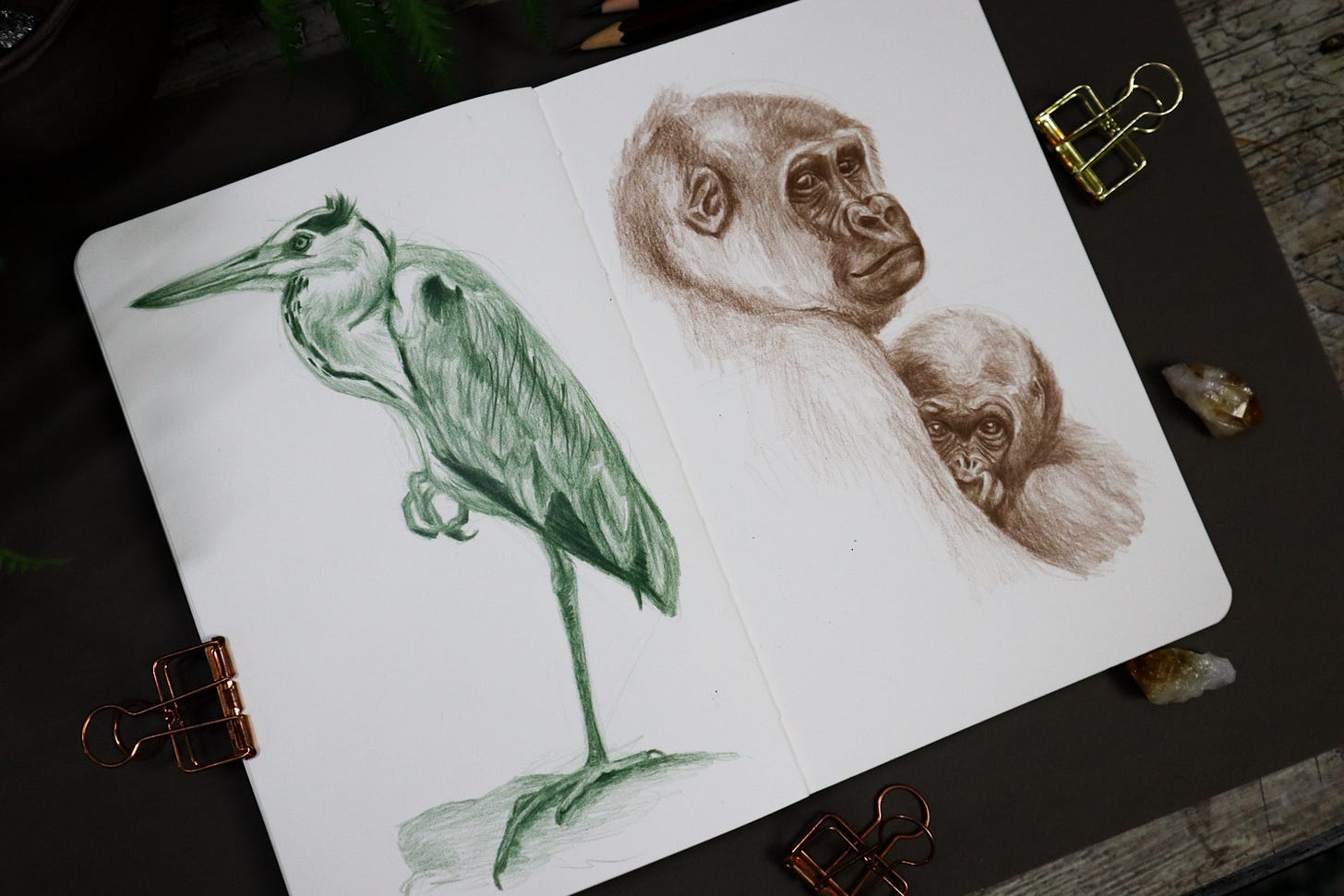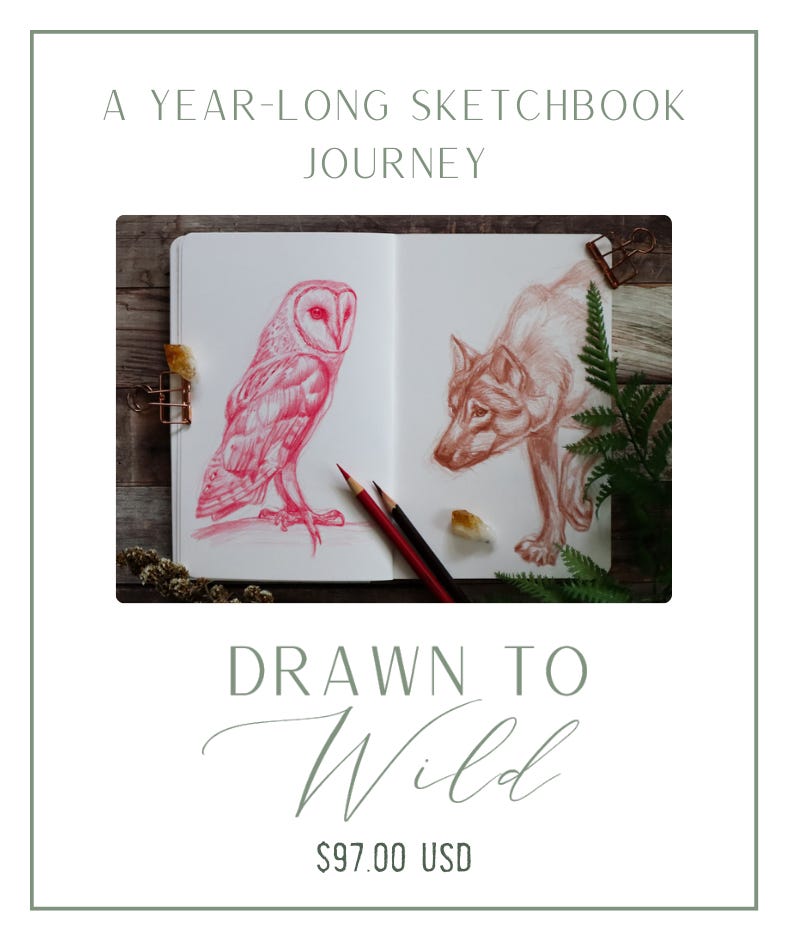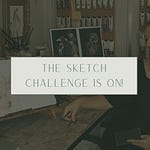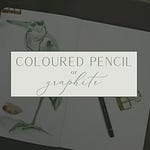Real talk today.
Hello, my name is Natalie, and I have multiple chronic illnesses that leave me in constant fatigue and pain, and I have diagnosed anxiety and depression.
Some days are harder than others, yep. But mostly I manage like all of us wonderfully complicated humans do, living in a time of the world where there is so much expectation, the constant barrage of stimulus, and very little peace (individually and globally).
One of the most significant ways that I tend to the self care I only realised in the last few years is desperately necessary in order to function at any level, is connecting to the wild world. To wildlife, particularly.
Connecting to wildlife through art is self care.
Connecting to wildlife through art provides a wealth of respite from the mental exhaustion of living in a chronically fatigued, pained, tired animal body.
Connecting to wildlife through art is a large part of how I celebrate the complexity of my physicality, the reality of my perfectly imperfect animal body, even when it is hard.
Connecting to my wild kin through art allows me to embody both my intellectual and animal reality through curiosity, compassion, and courage.
Connecting to my wild kin through art allows me to feel so much less alone in this beautiful wild world.
I have been thinking of how best to word all of this in my morning walks for the last week, and I don’t know if it is my own individual paucity of words or the English language itself, but I find it difficult to accurately convey the, well, magic, that is observing and honouring in pigment our wild kin.
At this point I kind of feel like interpretive dance might better convey the emotion of this experience. Wouldn’t that be a sight to behold! Please, let your imagination run wild - I know I am.
I will try with words first though.
I am going to break this down into three sections (and three letters to you here), and I would love to hear your own experiences, and any questions or thoughts you have. You can respond in the comments, or you can reply to this email - I am here for it all (and for you)
The physical act of sketching
The emotional act of sketching
The self care that is sketching
The physical act of sketching
I don’t know that this gets talked about enough.
We seem to find cerebral acts more virtuous for some reason.
As a society we collectively devalue physical labour careers over intellectual ones. Yes, we are mammals with huge brains that can overthink even the tiniest of things, but we are still animals. We have an animal body. We only have all the buildings in which we do the intellectual things and all the astoundingly nutritious food to fuel ourselves year round thanks to those who expended vast amounts of physical energy to build them, grow them, harvest them, transport them.
We need to be physically active to be healthy of mind and body (to the degree to which our body’s are capable), because, well, we are animals.
Making art, sketching, scribbling, is not an intellectual pursuit. Or it is not only an intellectual pursuit. It is a physical and emotional one. Yes, we have to observe and imagine and process, consider, learn, and understand, but we have to move.
When we write we tend to only move our wrist, and grasp the pen (or quill!) quite firmly. The rest of our arm, shoulder, and even neck, can be quite tight and strained. When we sketch we want to be dancing with the pigment and the paper. We want to involve our whole body, because sketching is a way to celebrate being an animal, having an animal body.
We move with fluidity and grace as we push colour around on a surface that was once trees and plants. We can’t do anything else. If we are tight and reserved as we work, we pinch off the flow of creativity, or at the very least dam it to a slow trickle.
We need to move. We need to feel loose and limber to embrace flow.
In movement there is release, and joy. And for me, when focused on wildlife, there is a whole other element to sketching that, oh, I celebrate.
As I move my pencil to honour and revere the being I am deeply focused on, I am taking them into my body through my eyes. There is a part of them inside me now, how could there not be? We have connected. And so I can choose to not intellectualise, but embody them. I can choose to move my animal body as an artist would, AND I can choose to become who I am honouring. I can roll my shoulders and unfurl my wings. I can imagine my strong legs running through forest unencumbered, unafraid, free. I move my body to capture that feeling, even as I am moving my pencil over the page.
A dance, see. A dance between the pigment, the paper, the wild, and me.
Sketching is a physical act, and the more we embrace that, the more free we become to inhabit our animal body with love and reverence - the same love and reverence we show towards the wild beings we are celebrating.
You will hear me inviting you to become the wildlife we are observing in my classes. I want this so much for you - I want you to celebrate your animal body and the amazing strength and resilience you have built to live through the harsh complexities of a world where we are so far removed from the wild we were born into (and where we thrive when in reciprocal connection to).
I want this deep and abiding connection for you - you deserve it! You deserve to remember your wildness. To dance with pigment and paper and wild kin and your wild heart.
Making art, sketching, is a physical act of curiosity and compassion and celebration. And we need that, that act of self care, don’t you think?
If you want to dance with - and become - a different wild being each week in a calm, considerate, and reverential way, Drawn to Wild is for you.



















Share this post